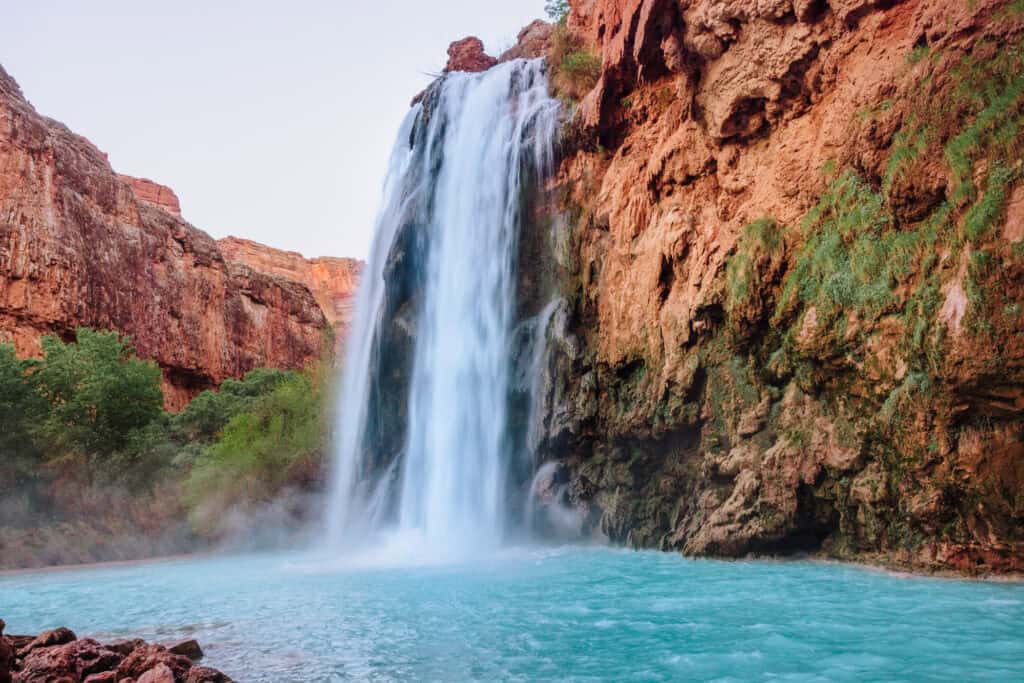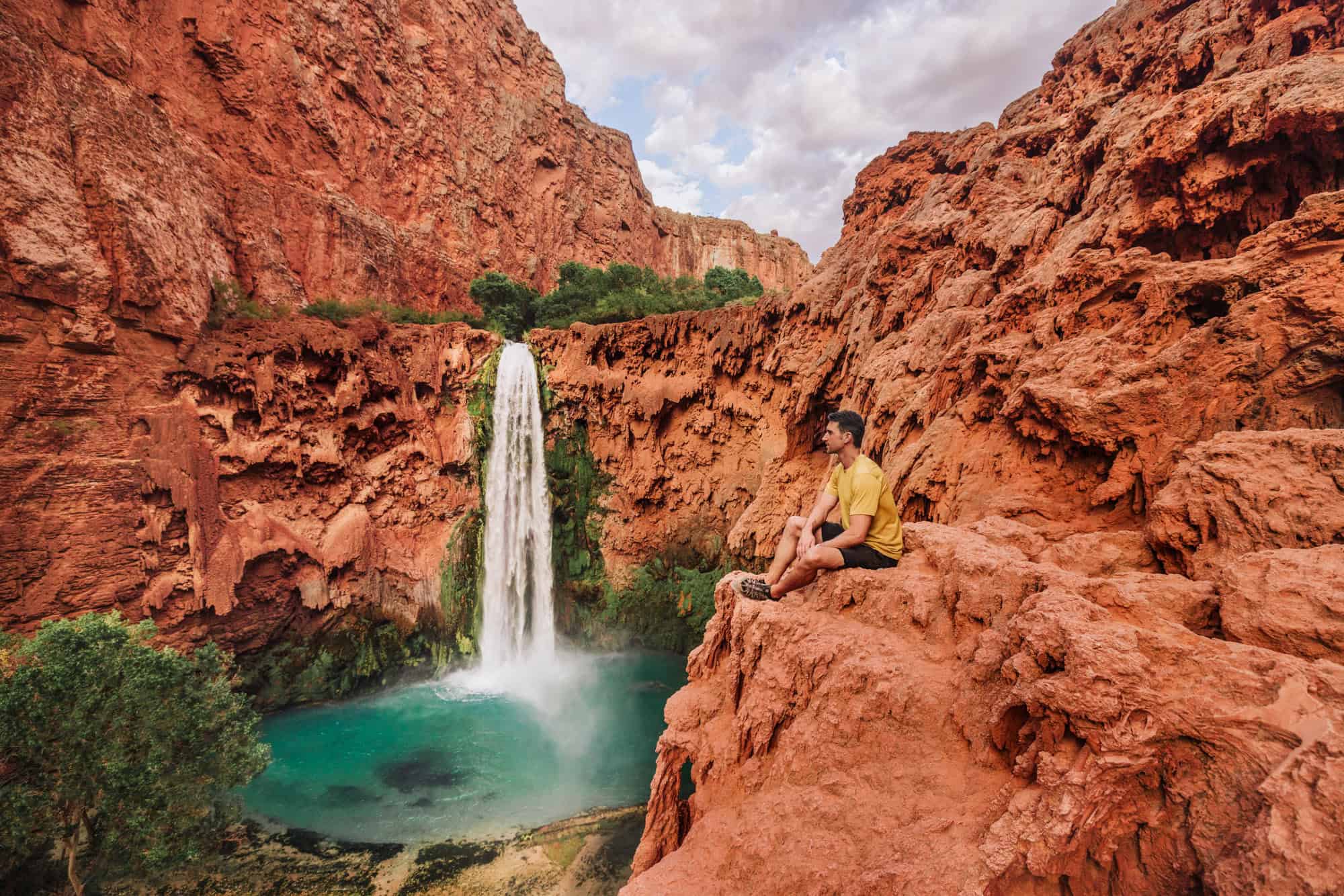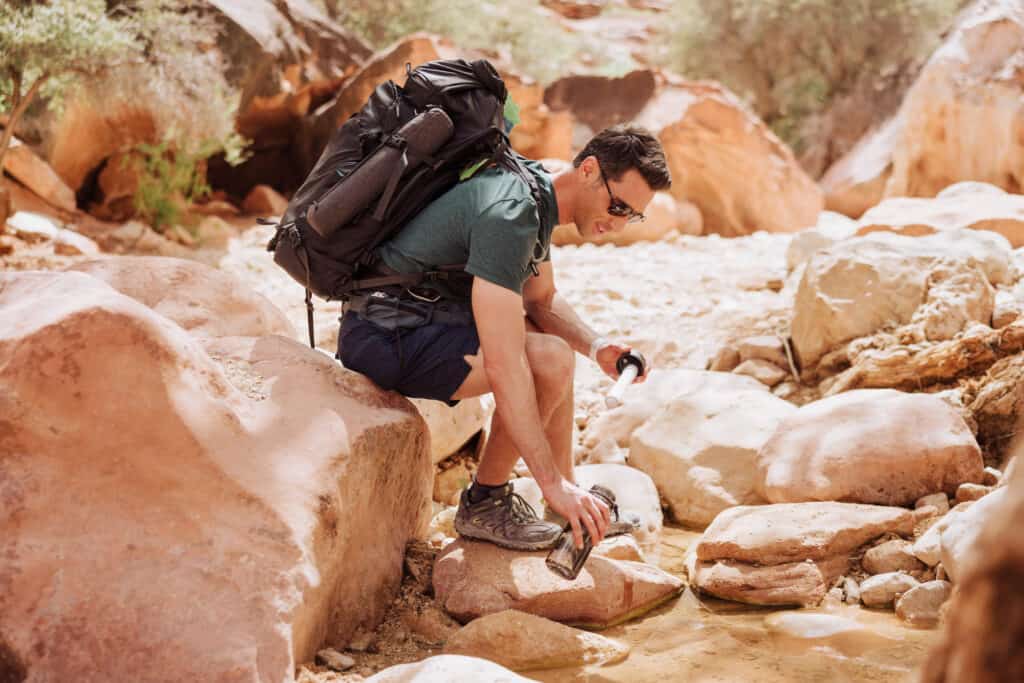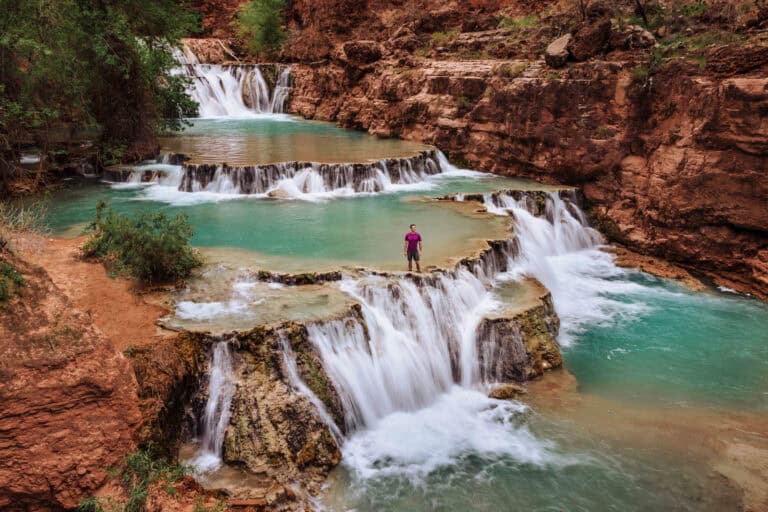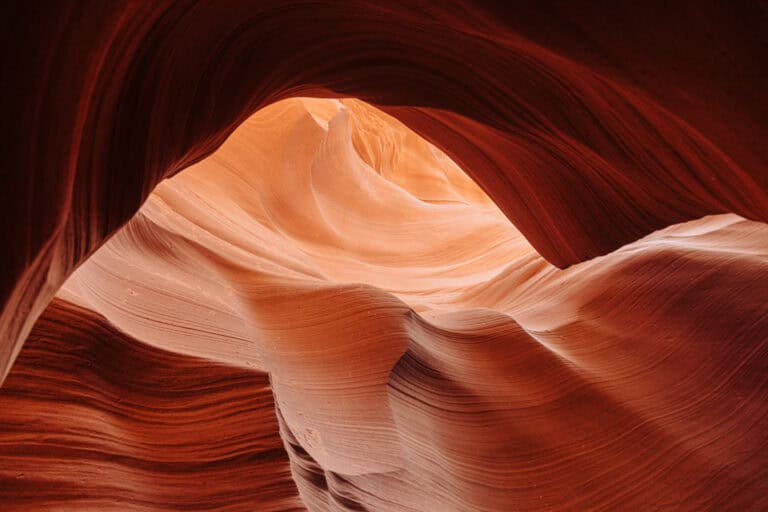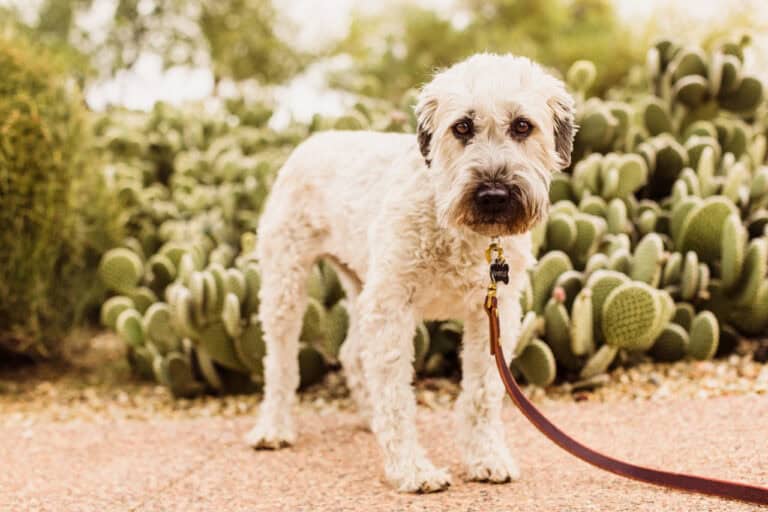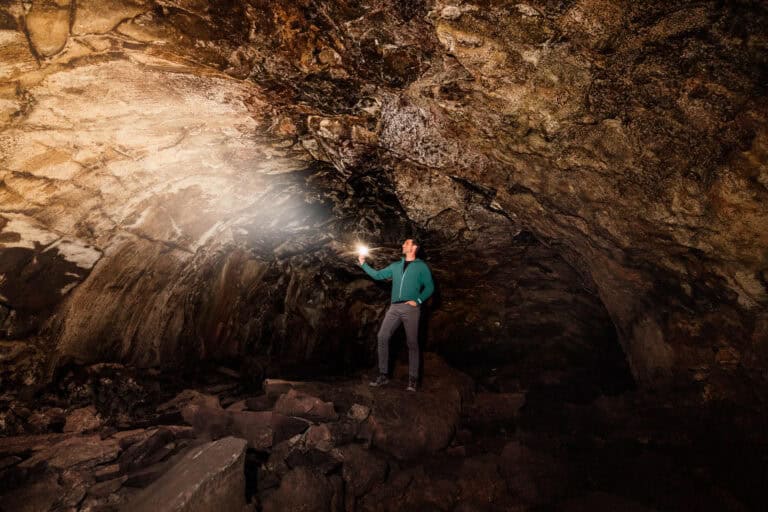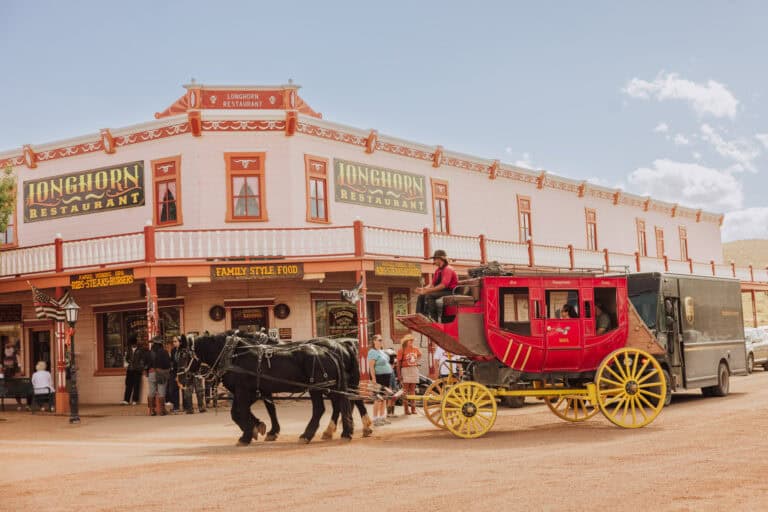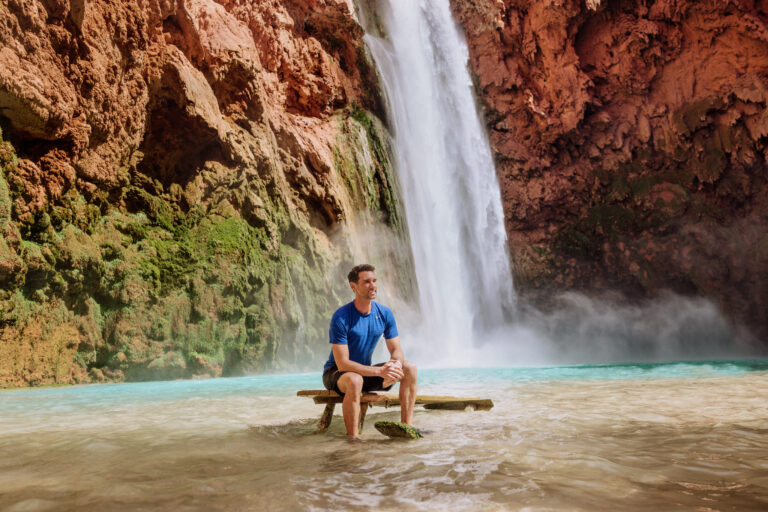An Arizonan’s Ultimate Guide to Havasupai Falls: Permits, Hikes, Camping, and More!

I love making the trek to Havasupai Falls. There’s no place like it! These days, it’s a “bucket list” item for people from across the United States and around the world.
Planning can be complicated, so I’m going to go through the basics, beginning with permits.
You can use the table of contents to skip around to different sections. This post includes all of the information I’ve learned over the years, which I’ve passed along to other hikers.
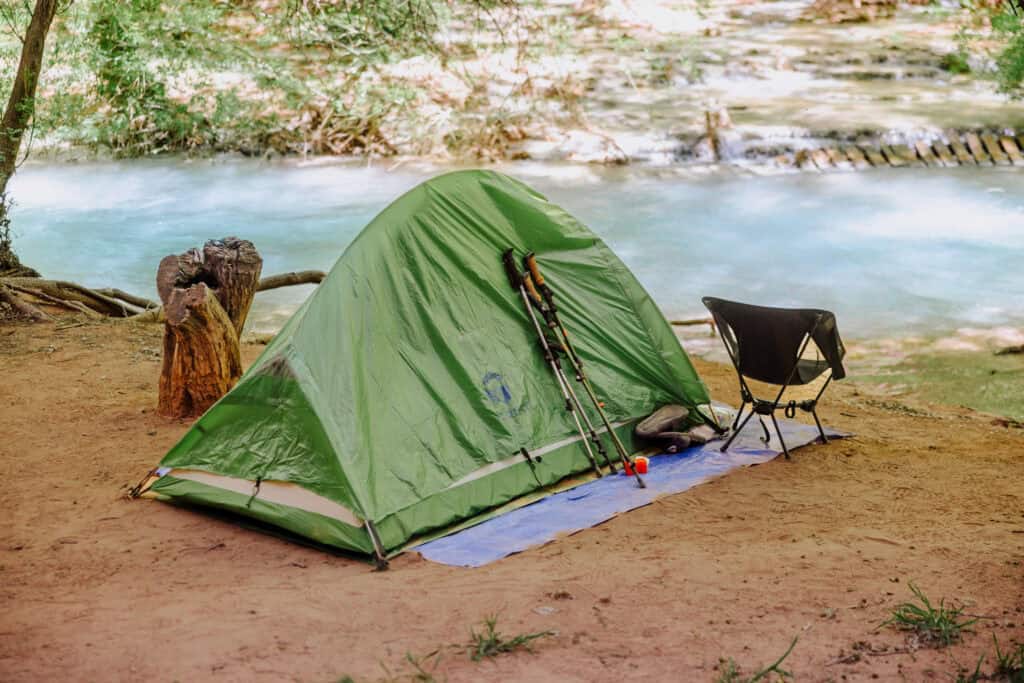
First, a few key pieces of information to know:
- You can’t go without a permit.
- The trailhead is in a remote part of Arizona, near the Grand Canyon.
- You can’t ride a mule, but you can hire one to carry your bags.
- You shouldn’t rely on the helicopter, though it may be an option.
- You can stay at the lodge in the village, or camp along Havasu Creek.
- The village is 2 miles from the waterfalls.
- You can’t take a day trip to Havasupai Falls (logistically it’s impossible).
- There’s little to no cell signal the whole time.
- It might snow in the winter, and hit 100+ in the summer.
If you’re good with all of those aspects of the trip, let’s get to the full, ultimate guide to Havasupai Falls!
How to Get Havasupai Falls Permits
You can’t visit Havasupai Falls without a permit, and they sometimes sell out quickly each year when they’re released to the public. The reservation process includes a presale lottery in December, before the bulk of the permits are released on February 1st.
Campground permits cover a three-night stay and cost $455 per person. If you prefer more comfort, the Havasupai Lodge offers basic accommodations for $2,277 for three nights, housing up to four people.
➡️ Havasupai Campground Reservations
If you don’t get a permit for your desired dates during the initial release in February, keep an eye on the cancellation list. The Havasupai Tribe releases unwanted reservations daily on its “Transfer” website, usually at 8:00 AM.
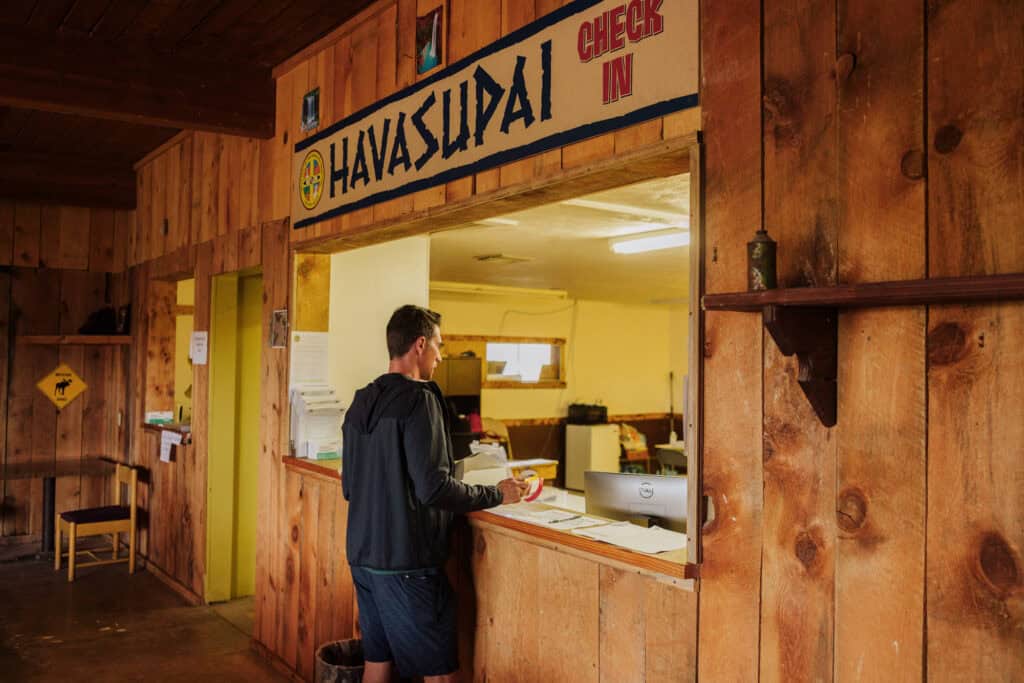
Getting to Havasupai Falls
The trailhead at the Hualapai Hilltop is remote, about an hour north of historic Route 66 near Seligman, Arizona.
Check-in takes place at the Grand Canyon Caverns Inn. The day before your hike, you pick up your permits and bracelets from an office at the motel.
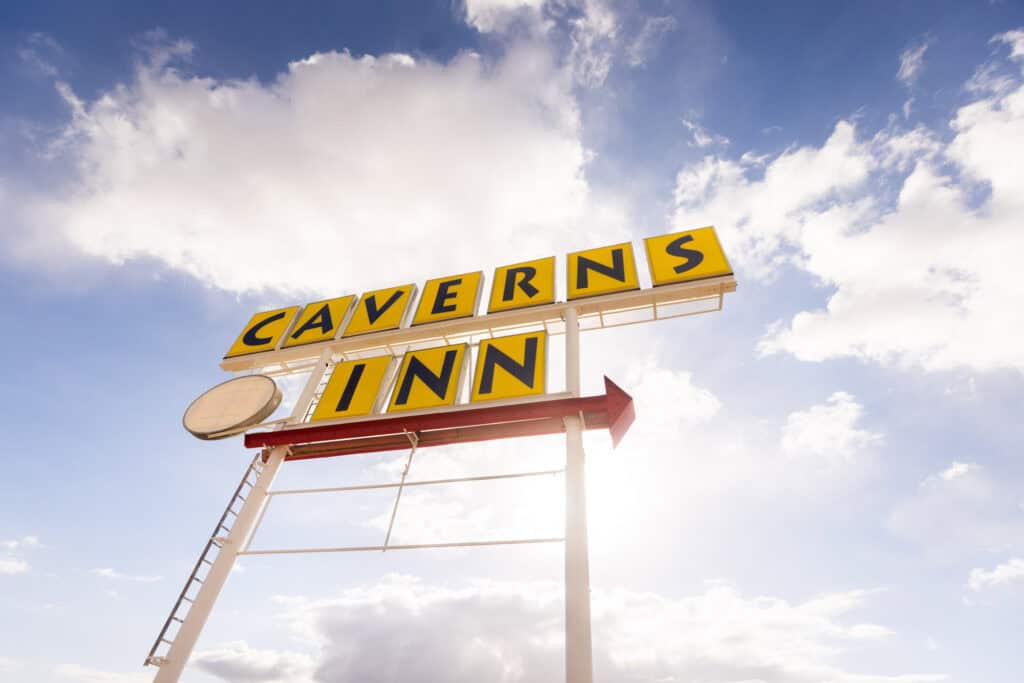
From there, you’ll drive to the Hualapai Hilltop, the starting point for the hike. Parking is limited. Most hikers will find the parking lot full, and have to park along the roadway.
Three Key Reminders
- There’s no water at the hilltop parking lot, so bring water and all supplies with you on the drive.
- Your last chance to make a call or send a text is on the road, just before the parking lot. Cell signal will be unavailable for most of your trip to Havasupai.
- Be sure to download maps ahead of time, and switch your phone to airplane mode to save battery.
Additionally, the Havasupai Tribe may have someone staffing a checkpoint along the road (photo below), about five miles before the parking lot. They claim to cut off entry each day by 2:00 PM, so plan to arrive earlier to begin your hike.
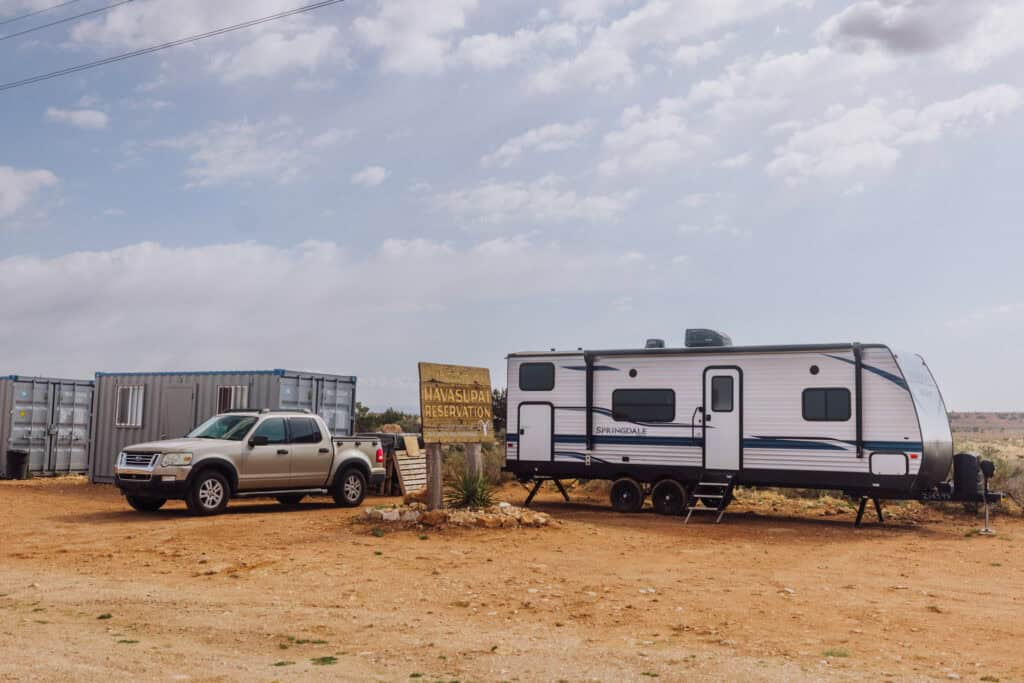
At the hilltop parking lot, you’ll find a small ranger station (which may not even be staffed) and vaulted toilets.
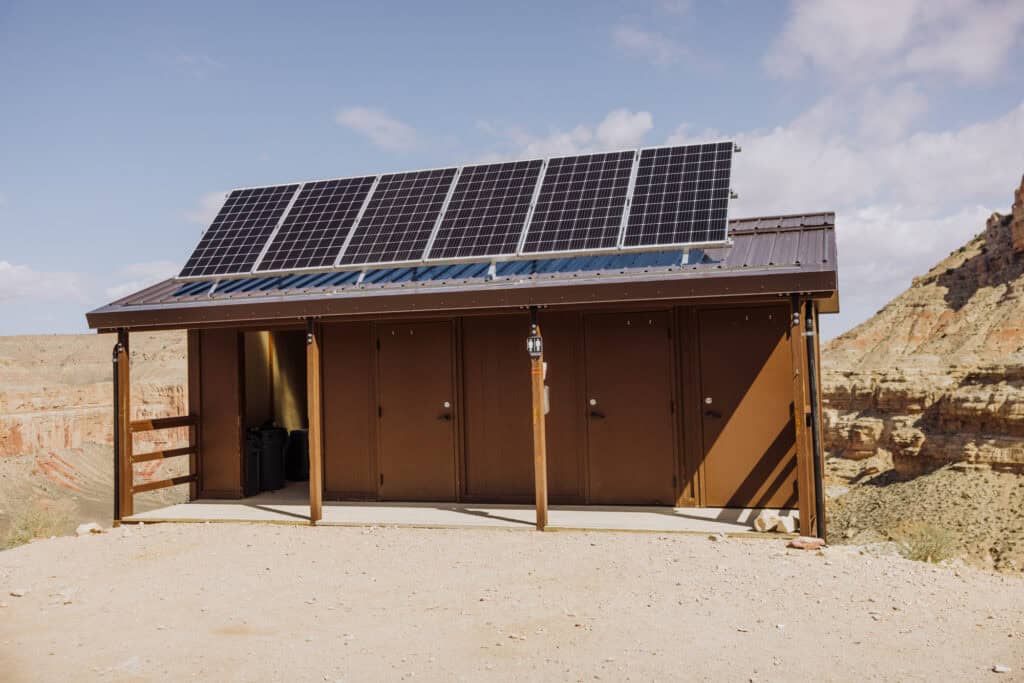
Mules may be tied up, waiting for their next haul of luggage or mail deliveries. This is also where you’ll see the helipad for the chopper that flies back and forth. There are no other services at the parking lot.
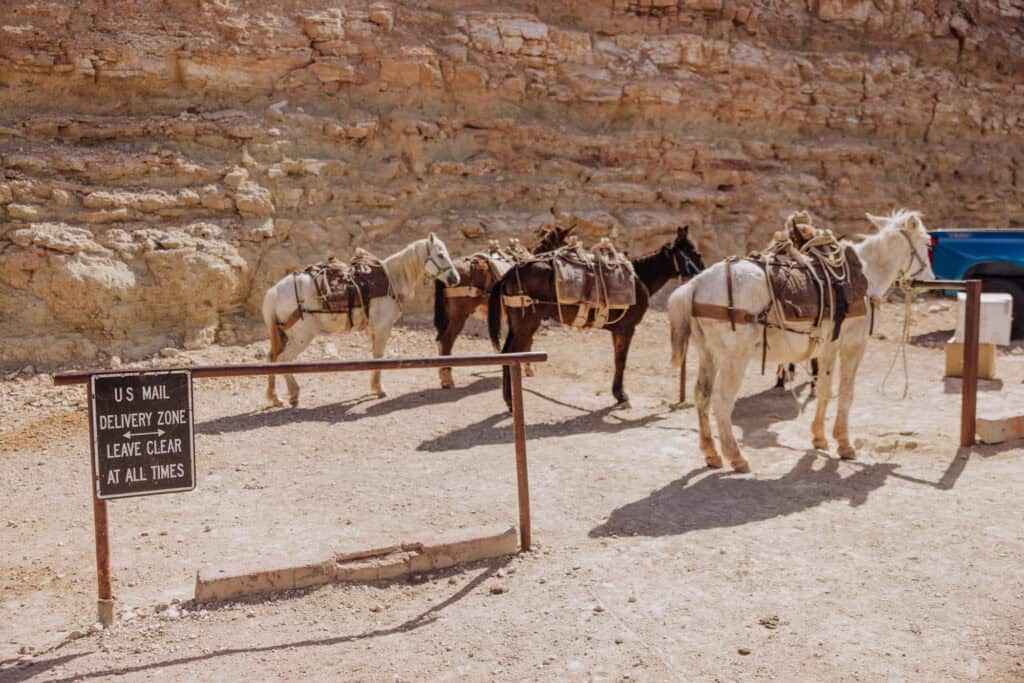
The 11-Mile Hike to Havasupai Falls
The hike is challenging, with no water sources for much of the way. While the sign says 10 miles, it’s really closer to 11 miles from the Hualapai Hilltop to the Havasupai Falls Campground.
The first two miles of the hike are a series of steep switchbacks descending into the canyon.
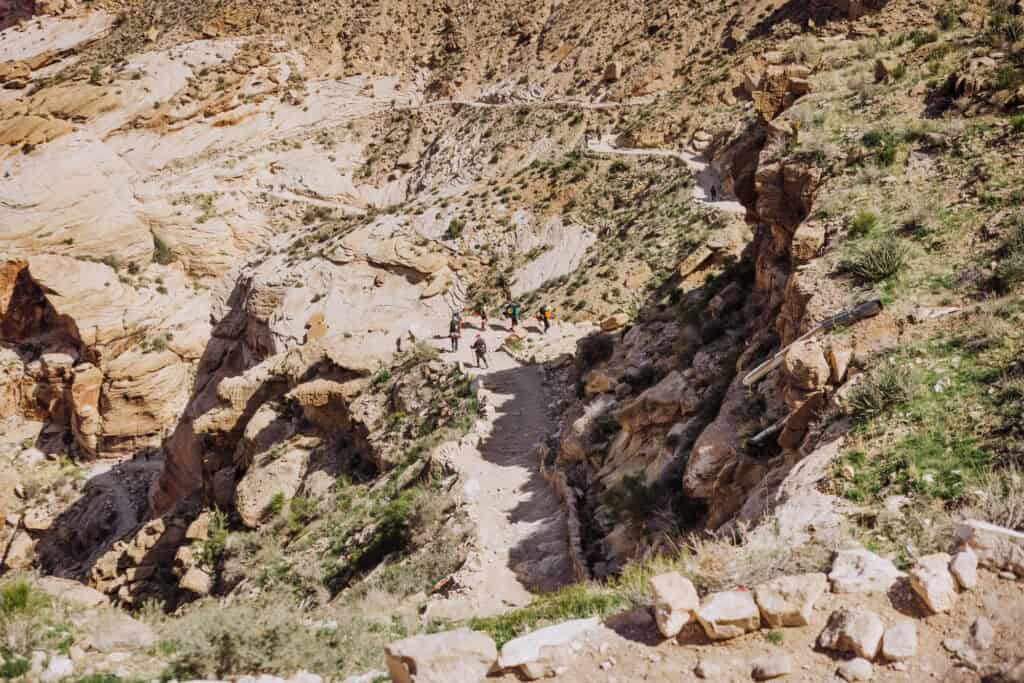
It’s followed by five miles of relatively flat terrain with occasional shade, surrounded by tall rock walls.
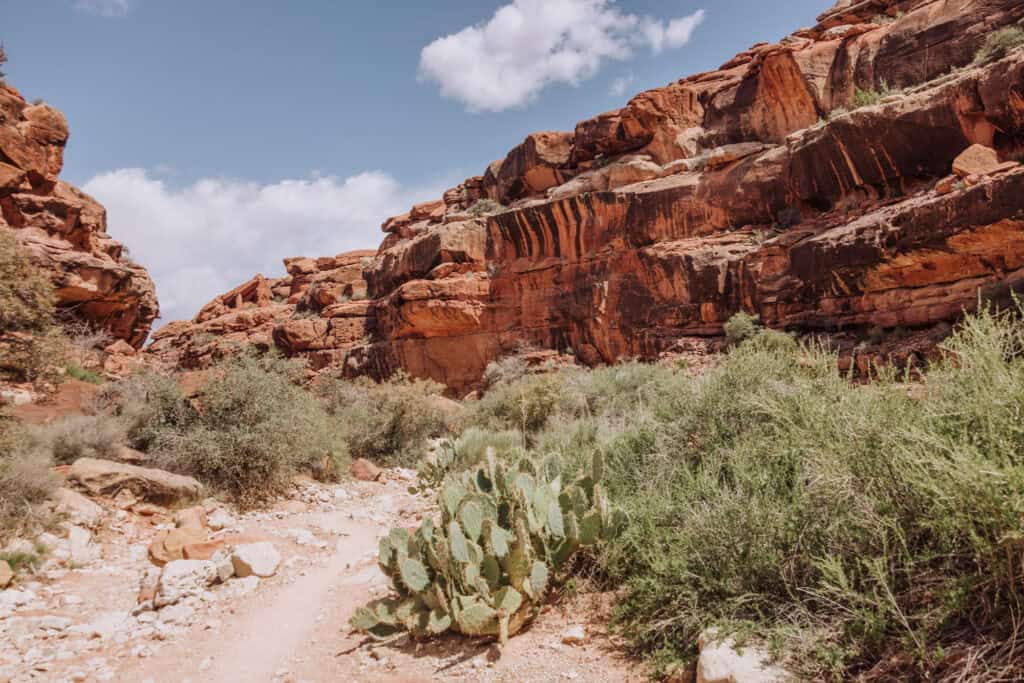
The final three-mile stretch passes through a shady forest into Supai Village, and follows Havasu Creek to the waterfalls.
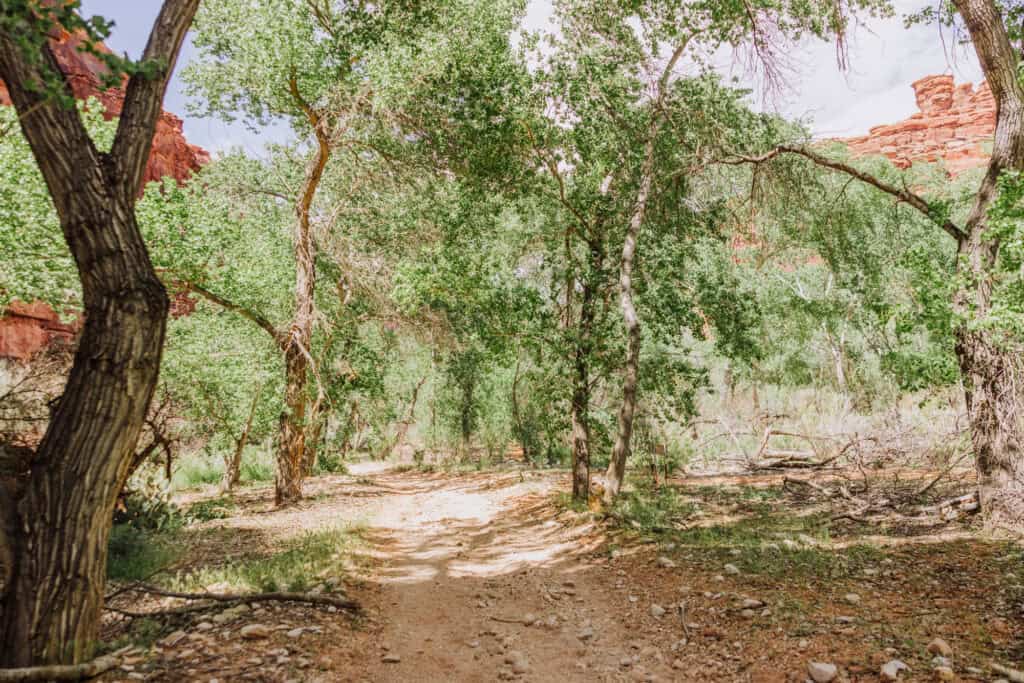
Seasonal conditions impact the hike:
- Summer: Start before 4:00 AM (wearing a headlamp) to avoid extreme heat.
- Winter: Limited daylight (7:30 AM – 5:00 PM) means you should start before noon.
- Spring/Fall: Midday hiking is manageable, but check the forecast for temperature fluctuations.
Supai Village
Supai Village is about 7 miles from the parking lot.
Photography is banned, to respect the privacy of the 500 or so people who live there. The village market sells drinks and snacks, and there’s a cafe in town, too.
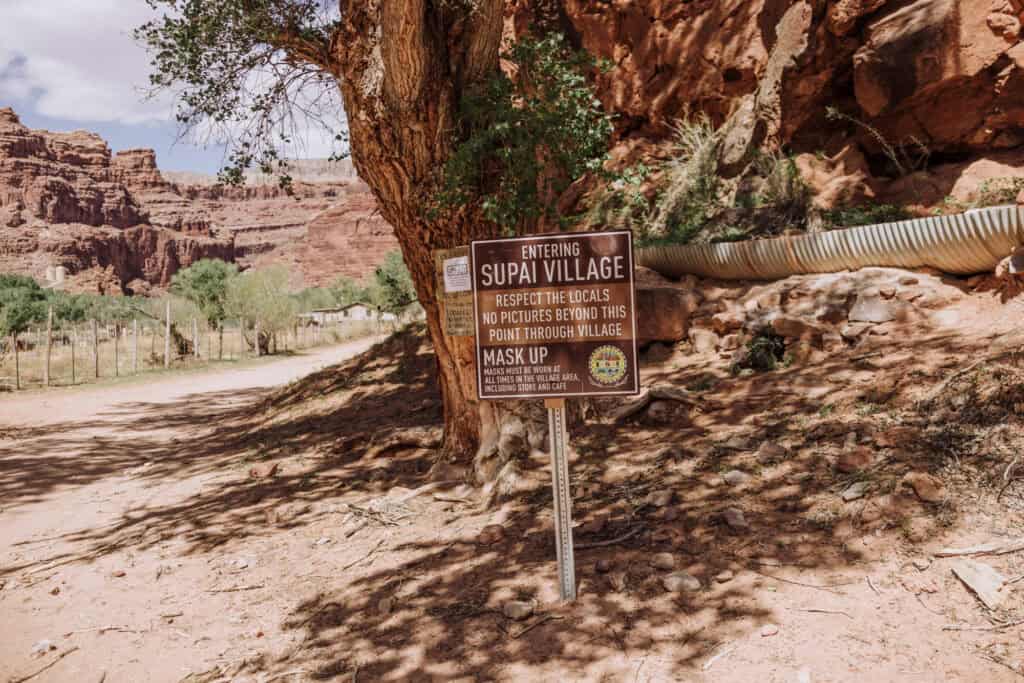
Where to Stay: Lodge vs. Campground
I’ll likely always stay at the campground, because it’s right along Havasu Creek and close to the waterfalls. The lodge, which was renovated in 2023, is also popular.
The Havasupai Lodge
The Havasupai Lodge is located in the village of Supai.
Keep in mind: it’s a two-mile hike from the village to Havasu Falls. Still, a lot of people prefer the lodge to the campground, since it offers air-conditioned rooms and showers.

The rooms are pretty basic. Each room costs $2,277 for three nights.
You can’t buy a partial stay. If you split it among four people, the cost breaks down to $190 per person, per night.
Check-in time for the lodge is from 2:00 – 5:00 PM each day. Check-out is by 11:00 AM.
Each room has two queen beds, towels, soap, and possibly a couch and microwaves. The courtyard outside has grills to use.
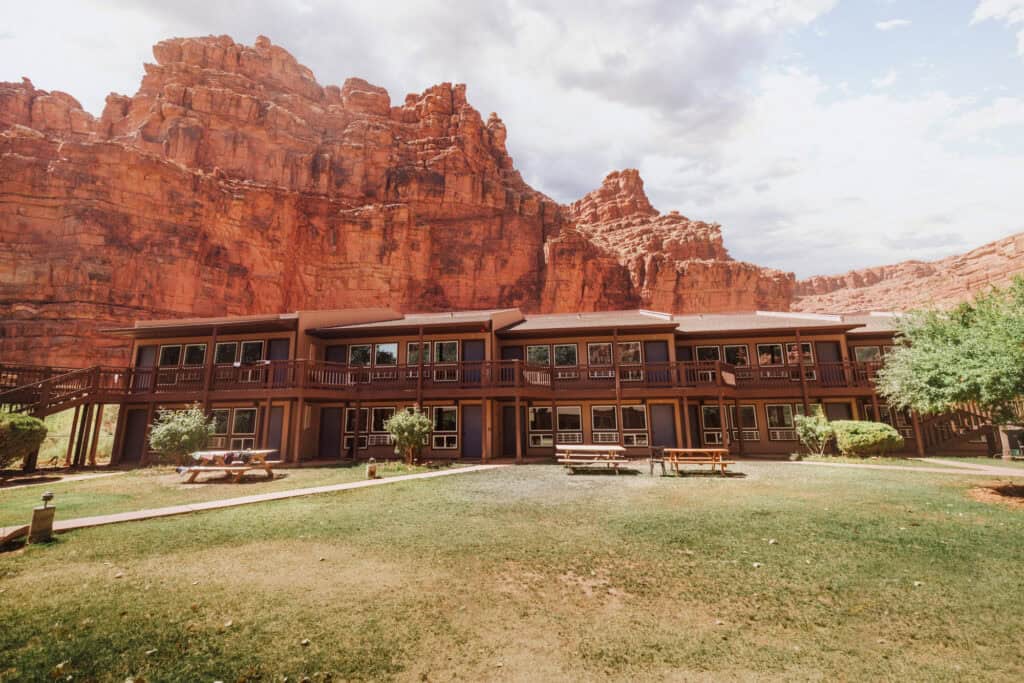
The Havasupai Campground
For a more immersive experience, the campground is located along Havasu Creek. It runs for a one-mile stretch, with Havasu Falls at the south end and Mooney Falls on the north end.
Pick a campsite with a picnic table, and avoid those near the bathrooms due to odor issues. The bathrooms can be very clean or badly in need of attention.
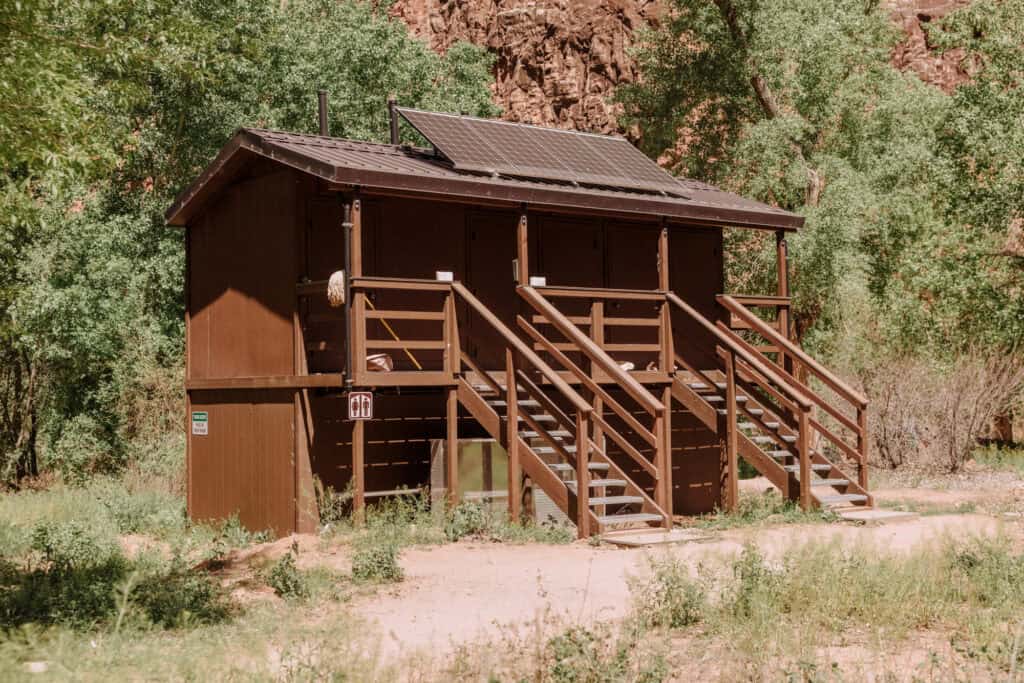
Fires, alcohol, and drones are prohibited, and you’ll need a water filtration system to drink water from Fern Spring or Havasu Creek.
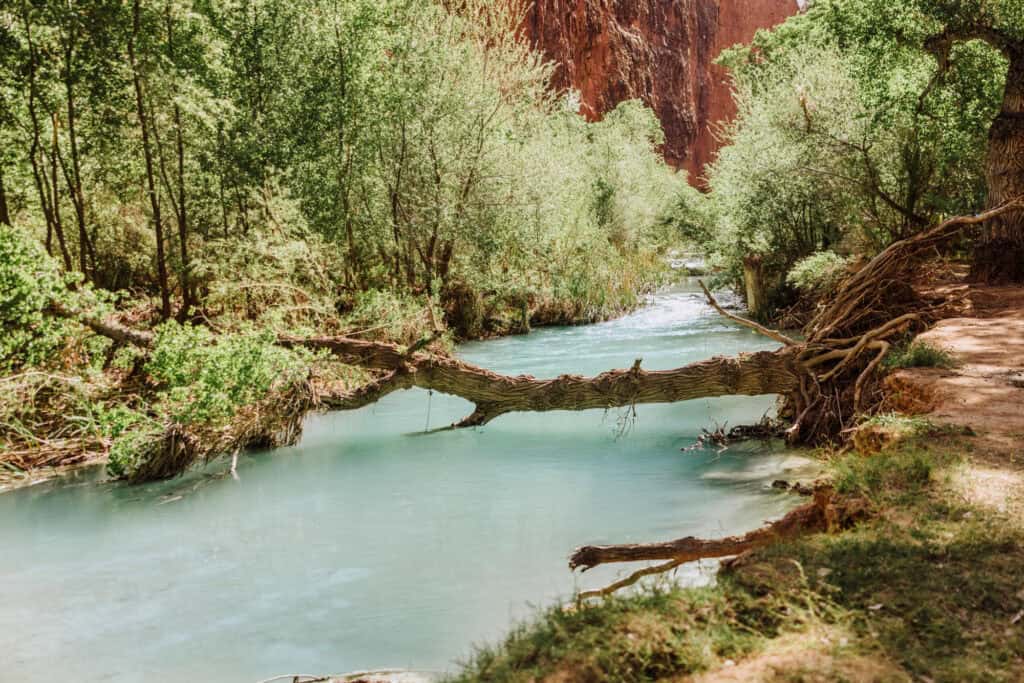
Considering Trip Insurance
I purchase an annual international travel insurance plan every year, and it’s surprisingly affordable. However, Havasupai Falls isn’t covered under that plan, so I need a separate policy for this trip. I did a lot of research before choosing Travel Guard.
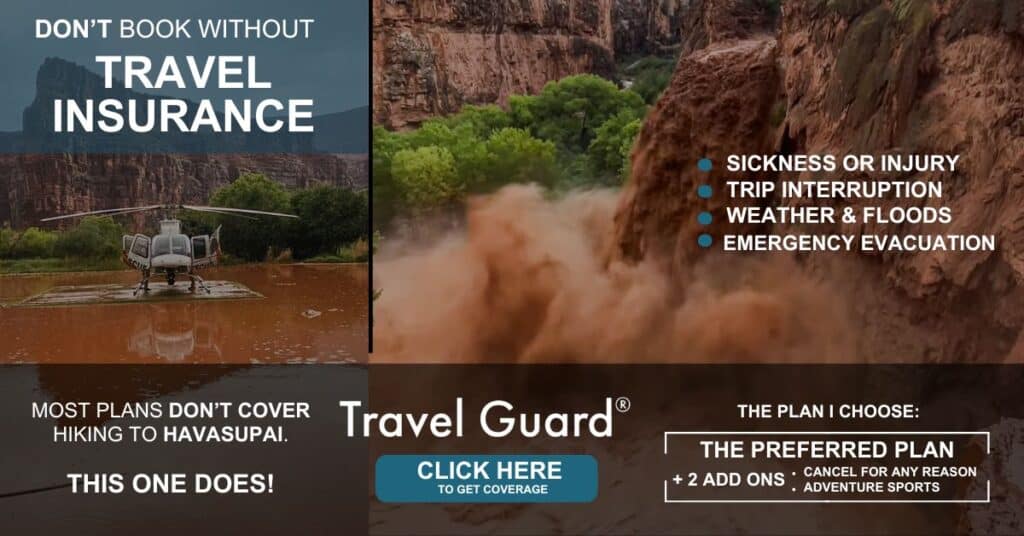
A trip to Havasupai Falls can get expensive quickly—permits, gear, hotels, rental cars, and flights (depending on where you’re coming from) all add up. Unfortunately, several factors could force you to cancel, including flash floods, changes in Tribal policy, or unexpected health or work issues.
When choosing travel insurance for Havasupai, make sure your policy:
- Covers cancellations due to illness or weather.
- Includes medical evacuation—because if you need a helicopter out, it’ll cost at least $10,000.
My Travel Guard policy cost less than $100 for my trip. I also add two optional upgrades: “Cancel for Any Reason” for extra flexibility and the “Adventure Sports Bundle” for additional coverage tailored to more active trips.
Hopefully, you’ll never need to use your insurance, but Havasupai’s remote and rugged environment makes it a smart investment for peace of mind.
What to Pack for Havasupai Falls
Especially if you’re hiking in and carrying your own packs, it’s essential to be as efficient as possible! After a lot of trial and error on my own trips to Havasupai, this is what I will now bring every time in the future. I’ve broken the list up by parts of the trip.
Must Haves
I’d never go to Havasupai without a few water filtration options. There’s a spring in the campground, but you’ll want additional filtering options. A LifeStraw Water Bottle & Filter will literally allow you to drink the creek water. In addition, a gravity-fed water bladder & filter is key to have at your campsite.
Especially in the summer, extra electrolytes are needed, so I’d bring a pack of powder or packets to start drinking *before* your hike in.
There are no power sources at the campground, so you’ll need enough battery life for the four days. I’d bring a minimum of 2 of these power packs, which have both USB-A and USB-C ports. We’ve tried 2 other solar-powered packs, but wouldn’t recommend them.
After sunset, you’ll need a headlamp. Make sure to get one with a red light option, since it’s less disruptive to other campers.
Campfires aren’t allowed, so you’ll have to bring a Jetboil system. The camp always has leftover fuel cannisters, but I always bring my own propane.
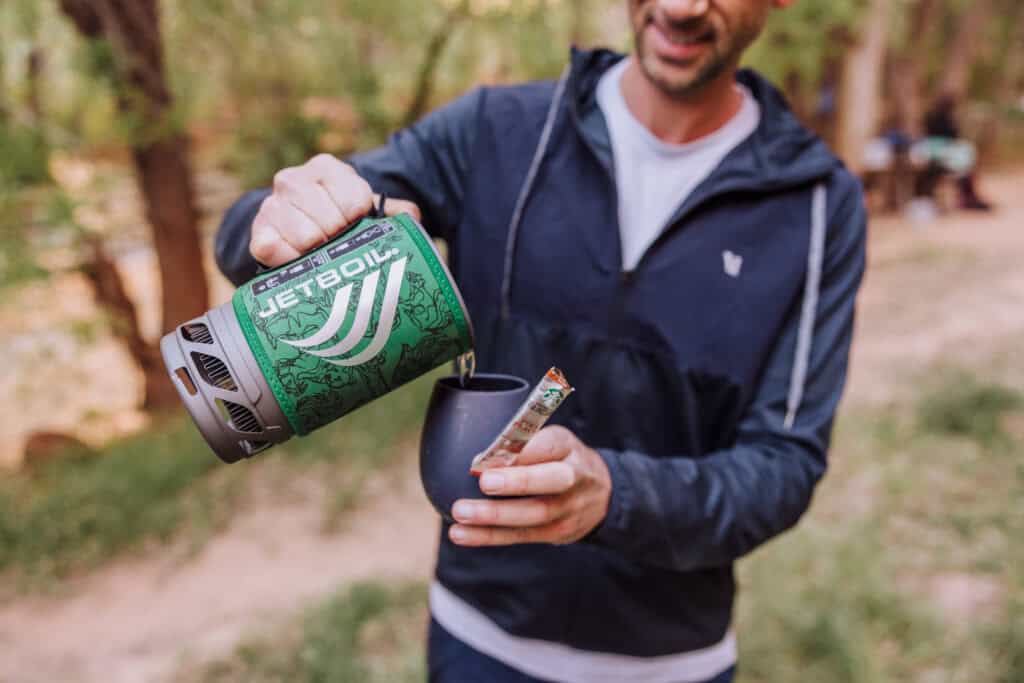
Hiking Gear
In addition to hiking shoes (or sandals) and flipflops to wear around camp, I’ll recommend bringing a pair of watershoes to swim in. Don’t leave home without Foot Glide! If you haven’t used it, it’ll prevent blisters on your hike in.
If you don’t already have a good backpack, it’ll be an expensive, but necessary investment for a trip to Havasupai. An additional smaller backpack is needed for day hikes. And while it may seem like overkill, I even wear a hiking fanny pack, which is where I store toiletries, etc. on the hike.
A set of lightweight hiking poles is optional. I don’t use them, but others wouldn’t dream of climbing the switchbacks on their way out without them!
Camping Supplies
Most people bring a lightweight tent, while others opt to sleep in a hammock. If you decide on a hammock, I’d also bring a bug net. always go for the tent, which also means bringing a sleeping pad, and sleeping bag or lighter-weight camping blanket in the summer.
You can bring an inflatable camping pillow, or use packing cubes as your pillow.
While some campsites will have a picnic table, it also helps to have your own foldable camping table for your bowls, utensils, and cups. I usually don’t bring one, but you’ll see many campers have brought lanterns with them. It’s personal preference! I’d also bring a first aid kit, because you’re guaranteed to have a few scrapes & bruises along the way.
In terms of personal hygiene, I like to bring:
- face wipes
- deodorant
- toothbrush & toothpaste
- some sort of environmentally-friendly soap
- SPF
- a half-roll of toilet paper
Clothing
I mentioned using packing cubes as a pillow. My advice is to pack less than you think you’ll need. if it’s spring or fall, bring layers to wear at night.
Good socks are key! You can’t just wear gym socks. It’ll be worth spending a little extra to save your toes and heals from blisters. I usually use a pair of sock liners, too, for added protection.
Food
We usually bring Peak meals to eat. Depending on your preferences, consider other options like:
- Nuts
- Protein bars
- Oatmeal
- Instant coffee and tea
While I’ve never had. problem, a lot of people bring Rat Sacks (to protect food)
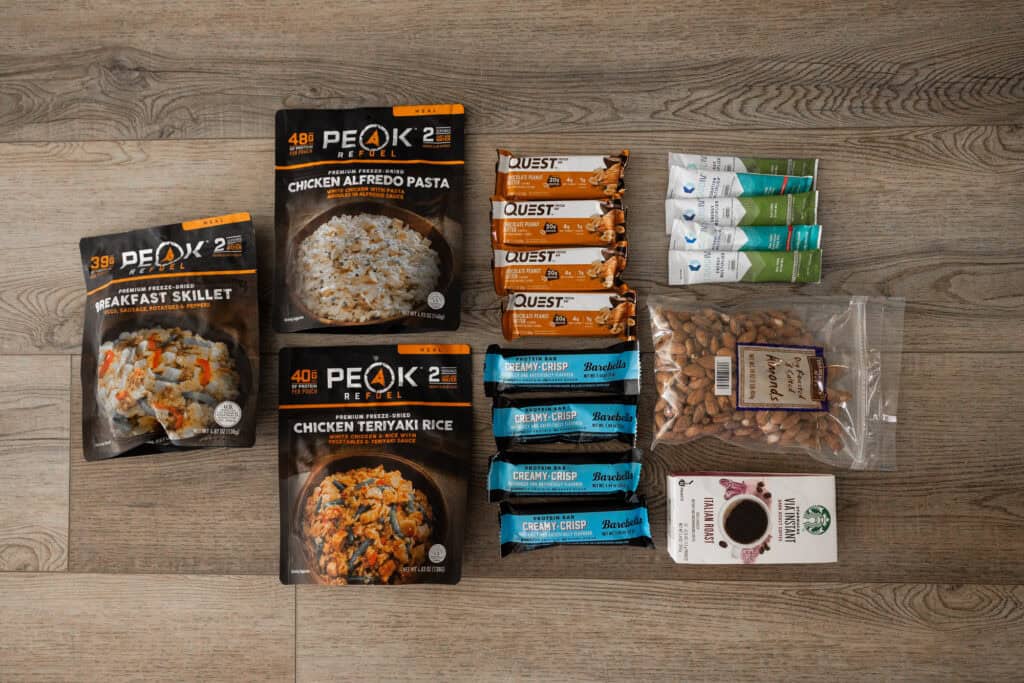
Extras to Pack
Here are a few more options to consider:
- Bug Repellent
- A tent fan for hot summer nights
- Climbing gloves (can even be garden gloves)
- Garbage bag (to haul your trash out)
- Pedometer (to track your steps and miles)
- Quick-dry towel (for hikes to Beaver Falls & the Confluence)
- Poncho (if there’s a chance of rain)
- Ziploc bag (for phone)
Mule Reservations
For those who don’t want to carry their gear, mule reservations cost $400 round trip ($200 each way) and must be booked when you purchase a permit.
I want to acknowledge: the mules are somewhat controversial. The Tribe has changed the rules, lightening their loads and making sure they’re better taken care of. I’ve never seen one abused or emaciated (like the photos you’ll see online) on any of my visits.
Each mule can carry up to four bags, with a max weight of 32 lbs per bag. The bag drop-off deadline is usually 10:00 AM at the Hualapai Hilltop.
I’ve never hired a mule, but it’s tempting. Many people wrap their bags in garbage bags or IKEA bags to protect them along the dusty route.
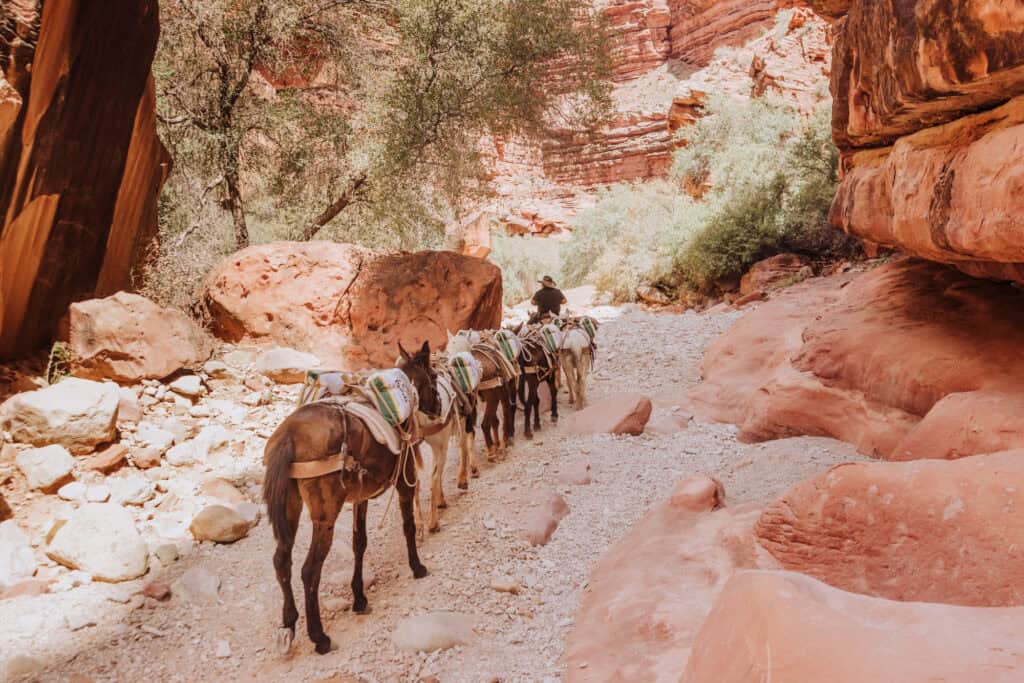
The Havasupai Helicopter
Visitors should never rely solely on helicopter transport for a number of reasons.
The schedule fluctuates, and it doesn’t fly every day.
Plus, locals get in line first, followed by contractors and others doing business with the Tribe. After they’re flown in or out, then tourists can start flying. It could take hours, and the sign-ups can be really organized or really chaotic. There are no advanced reservations for the helicopter.
The cost is $100 per person each way, plus an additional $50 for luggage. Flights typically run on Sundays, Mondays, Thursdays, and Fridays, starting around 10:00 AM.
I’ve seen people line up at 5:00 AM and wait until noon to fly in or out. I’ve also seen people line up at 9:30 AM and fly out just after 10:00 AM. There’s no predicting what kind of situation you’ll encounter.
Even when I suffered heat exhaustion and planned to fly out, I walked to the helipad to find I was number 113 on the list! I downed a bunch of electrolytes and hiked out, since there was no guarantee of a flight at all that day.
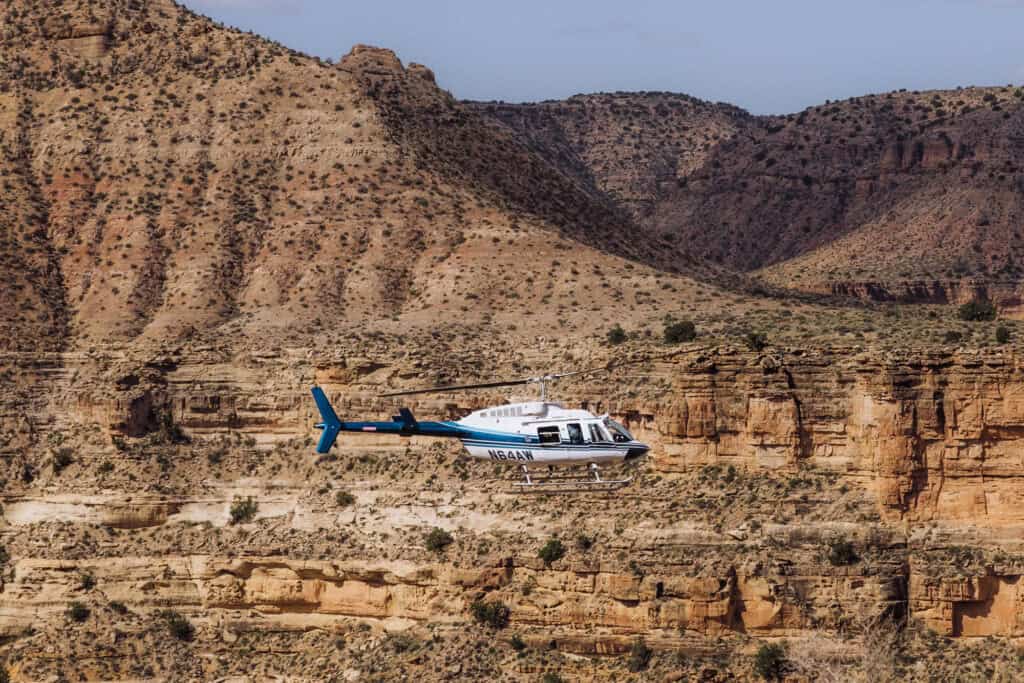
Havasupai Waterfalls
The waterfalls are the highlight of the trip to Havasupai, with their stunning blue-green waters caused by high lime concentrations.
Each waterfall offers something unique:
- Fifty Foot Falls: A hidden, less crowded spot, requiring a hike through water.
- Little Navajo Falls: Easy to access with great swimming.
- Hidden Falls: Small but picturesque.
- Havasu Falls: The most famous, located right at the campground entrance.
- Mooney Falls: The tallest, requiring a steep descent.
- Beaver Falls: A series of cascading pools and swimming holes farther downstream.
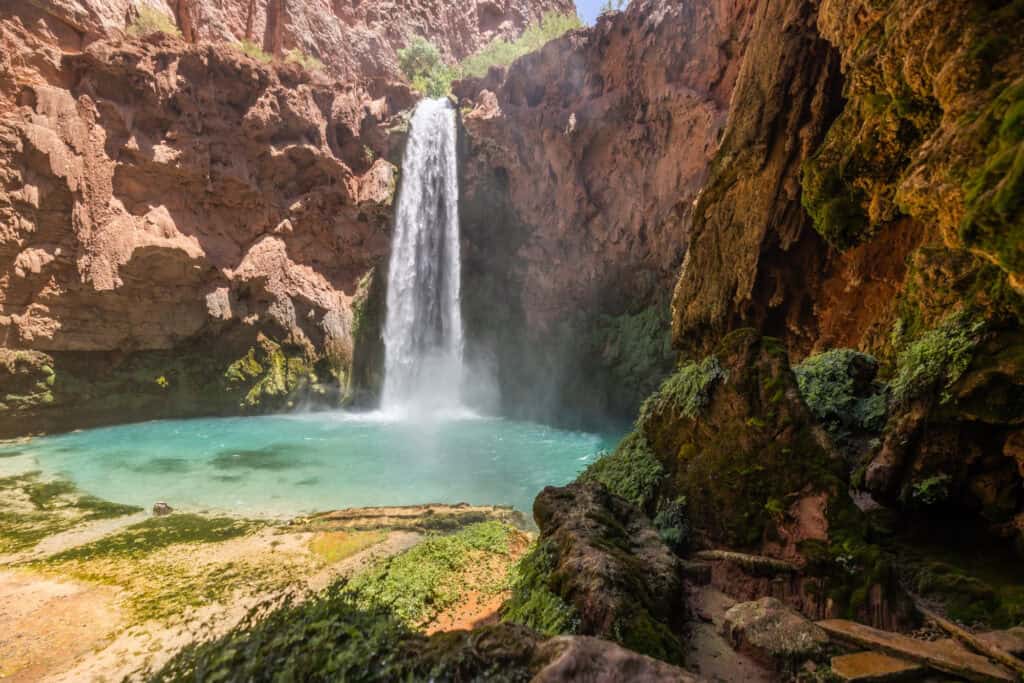
Warnings About Rescues & Injuries
Flash floods, often triggered by summer monsoon storms, have changed the course of Havasu Creek and the shape of the waterfalls over the years.
Usually, you’ll get a bit of a warning about floodwaters coming. Several times over the years, flash floods have forced campers to abandon their campsite and run for higher ground.
In September of 2024, a flash flood swept a woman to her death as she was near the confluence. The flood wiped out the campground, and the governor sent the Arizona National Guard to rescue 100+ hikers and campers.
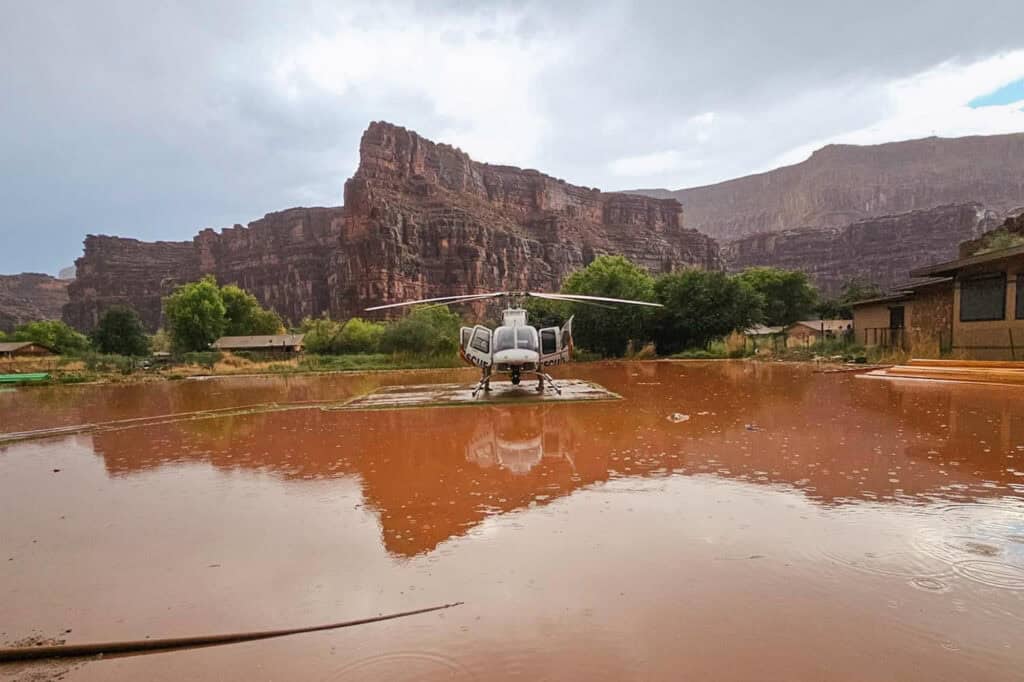
- In June of 2024, a wave of norovirus swept through the campground, sickening 100 or more campers.
- In July of 2023, as Arizona suffered from an intense heatwave, temperatures at Supai soared above 100 degrees. Many campers fell ill from heat exhaustion.
People have been injured at the waterfalls, too. The injuries are largely the result of people climbing the rocks and cliffs around Beaver Falls. Some victims slipped and fell, while others purposely jumped into the pool below and landed on rocks that are hidden underwater.
Helicopter rescues at Havasupai Falls are challenging and dangerous, and the injured hiker is responsible for the bill.
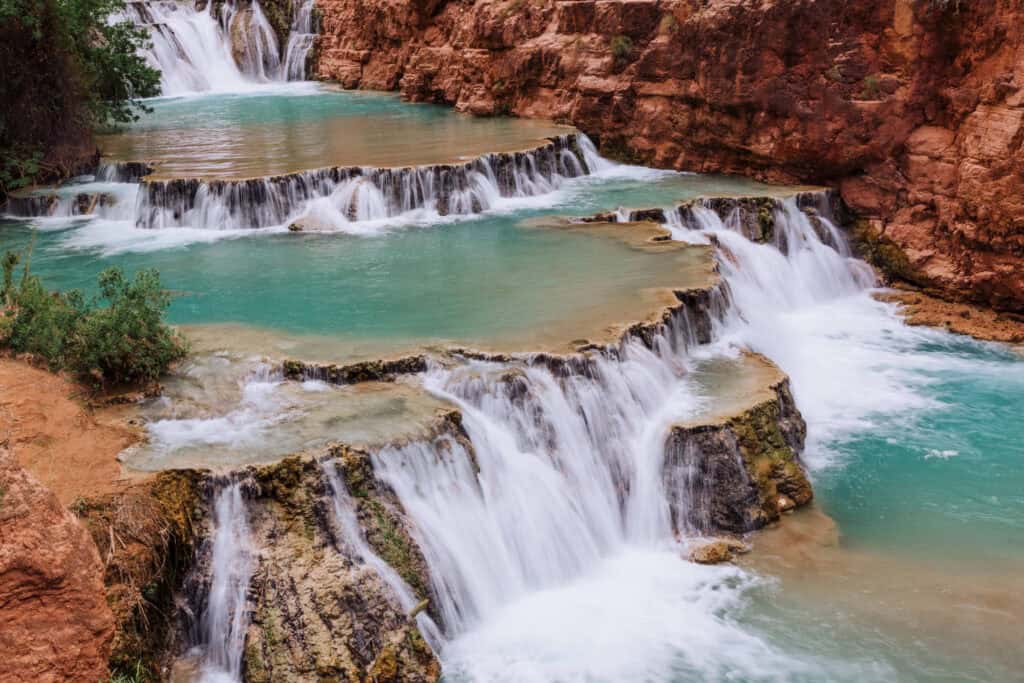
Distances Between Sites
For reference, here are a few distance markers for you.
Distances Between Sites
- Supai Village to Havasupai Falls Campground: 2 miles
- Supai Village to Havasu Falls: 2 miles
- Havasu Falls to Mooney Falls: 1 mile
- Mooney Falls to Beaver Falls: 3 miles
- Beaver Falls to Confluence (Colorado River): 5.5 miles
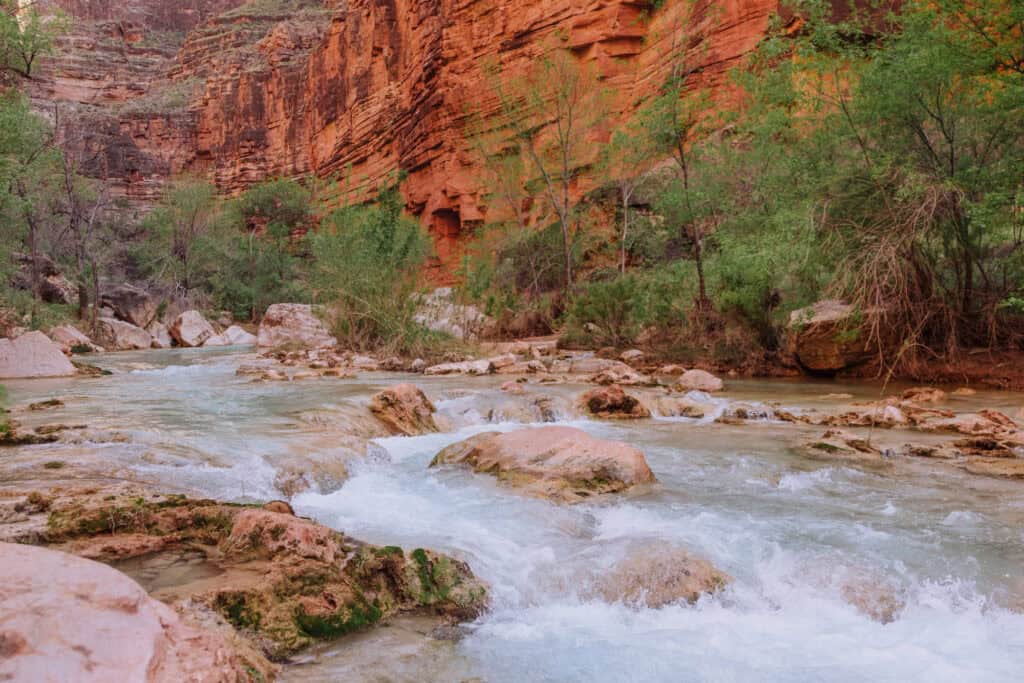
The Best Time to Go to Havasupai Falls
While I’d happily visit Havasupai Falls anytime, I generally find it too cold from mid-October through mid-April for swimming and enjoying the waterfalls.
My ideal window? April 15 – June 10:
It gets hot by the end of May, but it’s not unbearable. There’s plenty of shade along the hike, and the creek is perfect for cooling off.
By July, monsoon season kicks in, bringing the risk of flash floods through September. If you’re planning a trip during those months, be prepared for unpredictable weather.
Late spring to early summer is your safest bet!
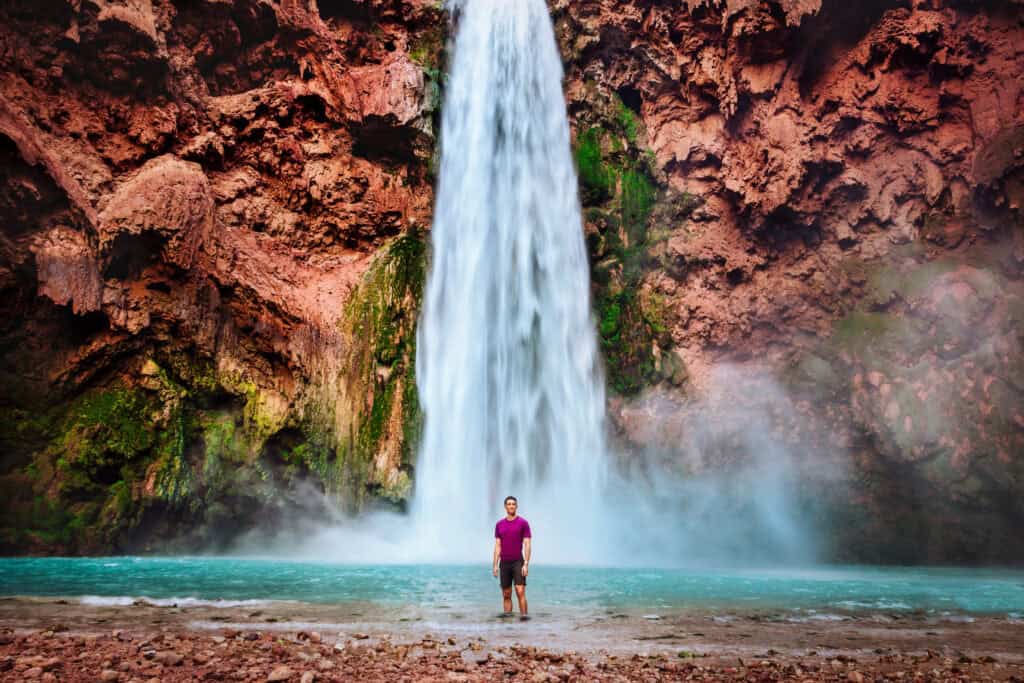
A Few Final Notes on Havasupai
I wanted to reiterate a few things, which I mentioned above and are key to a successful adventure to Havasupai Falls:
- Leave extra water, food, and fresh clothes in your car for after the hike.
- Expect unpredictability with flights, lodge check-ins, weather, and tribal policies.
- Prepare for extreme weather, from summer heat to chilly mornings.
- Respect the land and the Havasupai Tribe by following all rules and guidelines.
A trip to Havasupai Falls is an unforgettable adventure, but careful planning is essential. Secure your permit, pack wisely, and enjoy one of the most beautiful natural wonders in the southwest!
